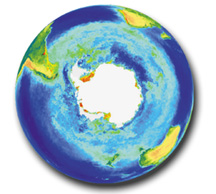 In
the cold Southern Ocean, the short supply of dissolved iron limits plant life.
The late John Martin proposed in 1990 that dust delivered iron to the Southern
Ocean during glacial intervals, creating an increase in productivity. This so-called
“Iron Hypothesis” had far-reaching effects for both geoscientists and policy-makers.
Increasing productivity in the Southern Ocean could draw more carbon dioxide
out of the atmosphere, creating a large carbon sink.
In
the cold Southern Ocean, the short supply of dissolved iron limits plant life.
The late John Martin proposed in 1990 that dust delivered iron to the Southern
Ocean during glacial intervals, creating an increase in productivity. This so-called
“Iron Hypothesis” had far-reaching effects for both geoscientists and policy-makers.
Increasing productivity in the Southern Ocean could draw more carbon dioxide
out of the atmosphere, creating a large carbon sink. For the past decade, scientists have used this hypothesis as fuel for experiments to fertilize the Southern Ocean with iron, but so far have found only temporary effects. Now, two researchers say they know why these experiments have failed. They offer an alternative source for glacial iron in the Southern Ocean.
The SeaWiFS image (above) from September 1997 to August 1998 shows chlorophyll concentrations. The light blue reflects the low productivity of the Southern Ocean, which extends from the coast of Antarctica to 60 degrees south latitude. SeaWiFs, NASA/Goddard Space Flight Center and ORBIMAGE.
Gabriel Filippelli, a professor at Indiana University, and Jennifer Latimer, his doctoral student, say that the upwelling of deep ocean waters brought increased amounts of iron to the surface. According to their “Upwelled Iron Hypothesis,” low sea levels during glacial intervals increased erosion of the continents and allowed land materials to flow from rivers directly into the deep ocean. The intensified circulation at the time helped to mix the material and bring nutrients to the surface. “When the deep water masses upwelled in the Southern Ocean, they were more iron-rich and thus fueled higher glacial bioproductivity,” Filippelli says.
He adds, “This situation has been observed for the modern high-nutrient, low-chlorophyll region of the eastern equatorial Pacific, where iron seems not to be supplied predominantly from dust but rather from upwelling of waters originating in the western Pacific. Thus, the limiting iron is supplied from below instead of from above.”
Filippelli and Latimer tested this hypothesis by studying sediment cores from the south Atlantic and south Indian regions of the Southern Ocean. The cores date back over approximately 250,000 years — two glacial-interglacial cycles. Filippelli and Latimer used geochemical techniques to identify elements in continental material and to measure the net surface bioproductivity. And, like John Martin, they found that “here was indeed a tight correlation for all the cores between glacial intervals with high iron and high biological productivity and interglacial intervals with low iron and low biological productivity,” Filippelli says.
But to their surprise, they also found that the flux of iron over time during interglacial times similar to today was 50 times that supplied by modern dust. Thus, Filippelli says, an upwelling source for glacial iron is more likely than a dust source. “Furthermore, the cores in different parts of the Southern Ocean have distinct geochemical signatures arguing for a variety of sources. And, in the case of one core, has a deep-sea, mid-ocean ridge signature that is nearly impossible to deliver via dust.”
Filippelli also points out that dust has a short residence time in the surface ocean. It quickly settles in days, usually before dissolving to any degree. “This has been seen in the seeding experiments, where the addition of massive amounts of iron to the surface ocean causes only a transitory fertilization due to the rapid downwelling of this added material out of the sunlit zones of the surface ocean.” The upwelled material, however, may have a residence time on the order of years.
These results, Filippelli says, call for a fundamentally different way to look at ocean-climate connections. Scientists trying to fertilize the Southern Ocean, he says, are developing technologies geared toward the surface waters. His upwelling hypothesis, however, indicates that deeper waters supplied the high flux of the glacial iron.
“Thus, not only is the proposed delivery system not mimicking natural processes, but it will likely be ineffective, because wewill not be able to match the intensity and duration of upwelled iron,” Filippelli says.
David Archer, a geoscientist from the University of Chicago, in 2000 wrote a paper in Global Biogeochemical Cycles that modeled dissolved iron in the ocean and, as with previous studies, showed that the ocean recycles much of its iron. But, he says, “Latimer is talking about something else: Water currents carry dust particles around, depositing them someplace where they did not land from the atmosphere.” Archer says Filippelli and Latimer document nicely that they are looking at particles, and not dissolved iron, by measuring the ratios of iron, titanium and aluminum.
“During glacial times, the accumulation rate of dust in the Antarctic ice cores went up, nicely in parallel with the accumulation of dust in the sediment cores, but Latimer sees this as a red herring, or perhaps that every place was dustier. But still the pathway of the dust had to take an underwater leg to get where they ultimately found it.”
But the reliability of the hypothesis “comes down to the reliability of the estimates of deposition from the atmosphere — not an easy thing to measure, out there in that remote and stormy place,” Archer adds. And, he says, “the deposition data are really spotty — a factor of 10 disagreement here and there would not surprise me.
“The iron cycle in the ocean is a huge mystery, and there’s lots of room for revision in our meager understanding.”
Lisa M. Pinsker

